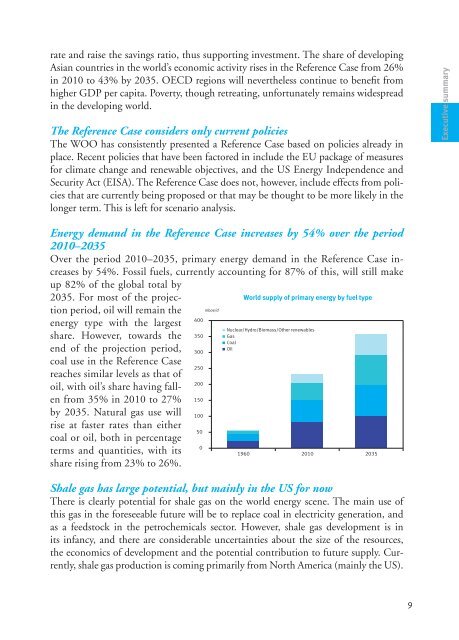World Oil Outlook - Opec
World Oil Outlook - Opec
World Oil Outlook - Opec
- TAGS
- world
- outlook
- opec
- www.opec.org
Create successful ePaper yourself
Turn your PDF publications into a flip-book with our unique Google optimized e-Paper software.
6.1<br />
re 6.6<br />
India<br />
rate and raise the savings ratio, thus 1,000supporting<br />
Chinainvestment.<br />
The share of developing<br />
Asian countries in the world’s economic activity rises in the Reference Case from 26%<br />
900<br />
in 2010 to 43% by 2035. OECD regions will nevertheless continue to benefit from<br />
800<br />
higher GDP per capita. Poverty, though retreating, unfortunately remains widespread<br />
in the developing world.<br />
700<br />
The Reference Case considers only current policies<br />
500<br />
The WOO has consistently presented a Reference Case based on policies already in<br />
place. Recent policies that have been 400factored<br />
in include the EU package of measures<br />
1990 1995 2000 2005 2010 2015 2020 2025 2030 2035<br />
for climate change and renewable objectives, and the US Energy Independence and<br />
Security Act (EISA). The Reference Case does not, however, include effects from policies<br />
that are currently being proposed or that may be thought to be more likely in the<br />
longer term. This is left for scenario analysis.<br />
Energy demand in the Reference Case increases by 54% over the period<br />
2010–2035<br />
Over the period 2010–2035, primary energy demand in the Reference Case increases<br />
by 54%. Fossil fuels, currently accounting for 87% of this, will still make<br />
up 82% of the global total by<br />
2035. For most of the projection<br />
period, oil will remain the<br />
energy type with the largest<br />
share. However, towards the<br />
end of the projection period,<br />
coal use in the Reference Case<br />
reaches similar levels as that of<br />
oil, with oil’s share having fallen<br />
from 35% in 2010 to 27%<br />
by 2035. Natural gas use will<br />
rise at faster rates than either<br />
coal or oil, both in percentage<br />
terms and quantities, with its<br />
share rising from 23% to 26%.<br />
1,100<br />
600<br />
millions<br />
Working age population in China and India<br />
<strong>World</strong> supply of primary energy by fuel type<br />
mboe/d<br />
400<br />
Nuclear/Hydro/Biomass/Other renewables<br />
350<br />
Gas<br />
Coal<br />
<strong>Oil</strong><br />
300<br />
250<br />
200<br />
150<br />
100<br />
50<br />
0<br />
1960 2010 2035<br />
Shale gas has large potential, but mainly in the US for now<br />
There is clearly potential for shale gas on the world energy scene. The main use of<br />
this gas in the foreseeable future will be to replace coal in electricity generation, and<br />
as a feedstock in the petrochemicals sector. However, shale gas development is in<br />
its infancy, and there are considerable uncertainties about the size of the resources,<br />
the economics of development and the potential contribution to future supply. Currently,<br />
shale gas production is coming primarily from North America (mainly the US).<br />
9<br />
Executive summary<br />
F<br />
B<br />
F
















